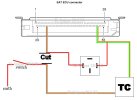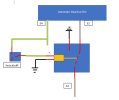You’ll need a switch, some wire, and a standard 30amp relay.
The reason for using a relay instead of a large resistor is it acts as a fail safe for the TCU. Even though you have manually energised the TC lockup the TCU still thinks it’s in control and will when it thinks it’s right will energise the TC. If a resistor is used it will short and put it in limp mode. So the TCU thinks it’s doing its job as it should.
The other reason is the TCU is constantly monitoring the system, if you splice in or cut the TC wire it will throw a fault and again enter limp mode. With the relay connected the TCU sees this as a connection to the Solenoid Valve as thinks all is well. Ok now I have bored the hell out of you here’s what you need to do.
1. Find pin 32 on the TCU, cut this wire but not too tight to the TCU.
2. Connect the wire from pin 32 to one of the pins on the relay. Either the + or - that energises the relay.
3. Connect a wire from the opposite side of the one you have just connected on the relay and splice it in to the wire on pin 53 which is the power supply to the solenoids. This connection allows the self diagnostics to see what it thinks is the solenoid valve.
4. Connect a length of wire to the wire that was connected to pin 32. Connect this to one terminal on your switch and the other to a good earth.
5. When you operate the switch you are supplying a direct ground to the TC solenoid valve which will energise it and lock your TC. You can do this in any gear, but don’t let it change gear when locked.
I hope all this makes sense, but let me know how you get on and if you have any questions please feel to ask.
Cheers
Tom.




